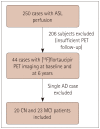Hypoperfusion Precedes Tau Deposition in the Entorhinal Cortex: A Retrospective Evaluation of ADNI-2 Data
- PMID: 36647226
- PMCID: PMC9982189
- DOI: 10.3988/jcn.2022.0088
Hypoperfusion Precedes Tau Deposition in the Entorhinal Cortex: A Retrospective Evaluation of ADNI-2 Data
Abstract
Background and purpose: Tau deposition in the entorhinal cortex is the earliest pathological feature of Alzheimer's disease (AD). However, this feature has also been observed in cognitively normal (CN) individuals and those with mild cognitive impairment (MCI). The precise pathophysiology for the development of tau deposition remains unclear. We hypothesized that reduced cerebral perfusion is associated with the development of tau deposition.
Methods: A subset of the Alzheimer's Disease Neuroimaging Initiative data set was utilized. Included patients had undergone arterial spin labeling perfusion MRI along with [18F]flortaucipir tau PET at baseline, within 1 year of the MRI, and a follow-up at 6 years. The association between baseline cerebral blood flow (CBF) and the baseline and 6-year tau PET was assessed. Univariate and multivariate linear modeling was performed, with p<0.05 indicating significance.
Results: Significant differences were found in the CBF between patients with AD and MCI, and CN individuals in the left entorhinal cortex (p=0.013), but not in the right entorhinal cortex (p=0.076). The difference in maximum standardized uptake value ratio between 6 years and baseline was significantly and inversely associated with the baseline mean CBF (p=0.042, R²=0.54) in the left entorhinal cortex but not the right entorhinal cortex. Linear modeling demonstrated that CBF predicted 6-year tau deposition (p=0.015, R²=0.11).
Conclusions: The results of this study suggest that a reduction in CBF at the entorhinal cortex precedes tau deposition. Further work is needed to understand the mechanism underlying tau deposition in aging and disease.
Keywords: aging; cerebrovascular; dementia; pathophysiology; tau.
Copyright © 2023 Korean Neurological Association.
Conflict of interest statement
The authors have no potential conflicts of interest to disclose.
Figures



References
-
- Alzheimer’s Association. 2019 Alzheimer’s disease facts and figures. Alzheimers Dement. 2019;15:321–387.
-
- Blennow K, Zetterberg H. Biomarkers for Alzheimer’s disease: current status and prospects for the future. J Intern Med. 2018;284:643–663. - PubMed
LinkOut - more resources
Full Text Sources

